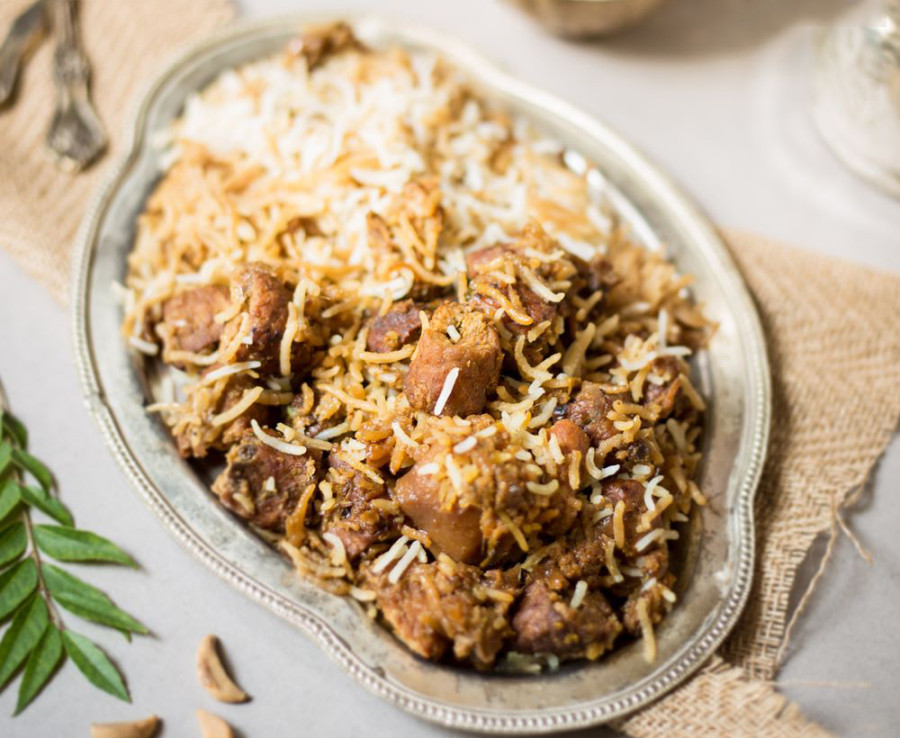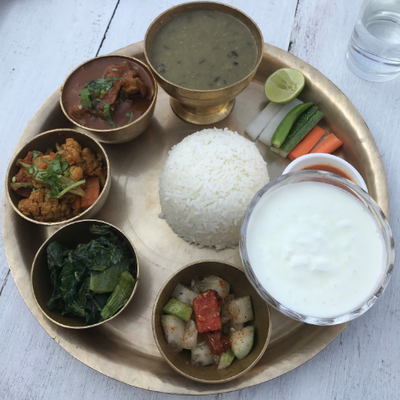Food
Where the biryani is the bomb
At Tasneem’s Kings Kitchen, the food will delight you, but there’s a frustrating disparity between price and portion.
Hantakali
The first few dishes—mutton shami kebab and chicken achari tikka—arrive in quick succession. Both are served with obligatory ramekins of green chutney and onion slices while the meaty morsels sit on a bed of cabbage confetti.
These are the first two tastes at Tasneem’s Kings Kitchen, which sits in a relatively quiet, quaint Newar-style building a few metres from Pulchowk on Jhamsikhel Road. Diners are guided through a pebbled corridor, past the bar, to an uncovered courtyard. Take the stairs and you will find a warm interior liveried with Bollywood posters, stained glass lampshades, and furniture flavoured by raw wood and khatiya-style weaving.
The restaurant, which opened in 2014, is the combined effort of Tasneem Shahani and Mumbaiite Abbas Nalwala, who runs the Mumbai catering business, Kings Kitchen. Unlike most places, this restaurant seems keen to tell a story—so eager that it’s placed its story on sheets betwixt the wood and glass of the tables, describing the ethos behind its food. The restaurant serves communal Bohra feasts, and models itself on the Muslim culture’s cuisine. The sheets expound the rituals around its dishes, and the significance of the food within its culture, as well as discussing the lavish and generous feasts its people take part in.
However, the first two dishes sampled lack any idea of opulence. The mutton shami kebabs are like crunchless croquettes, filled with a fine mince of mutton and spice, covered in an essentially flavourless coat of egg wash and shaped into a cylindre. The result is akin to an over-fried egg’s crispy peripheries—whether that’s good is up to the individual—but they do not have the seared crust and silken texture that can be found at Bismillah’s in Thamel. The masala’s earthy colours imbue the meat with a red tint while coriander adds an occasional pop to the flavour. While the deep spices are not overwhelming, they are not terribly exciting either. But the texture of minced meat and grain is unctuous and mouth-lining, even if the egg jacket feels rather odd.
The chicken achari tikka, fresh from the tandoor, glistens fat, black and amber. Cut from the thigh, the meat is juicy and a slightly more masala-charged cousin of the typical claret iteration. The tincture the meat is marinated in is on the acerbic side, speaking to its curd and lime marinade, and the pickling spices provide a nice departure from the common fire-kissed pungence.
However, the portion sizes for both these plates is sparse, considering the price. Seven cubes of chicken for Rs 500, not including taxes, seems a bit steep, as do the six sausage-like kebabs. The green salad—sliced carrot, onion, cucumber and daikon—that was ordered to abate the guilt of the carnivore is large though, and perhaps more appropriately portioned in relation to its Rs 200 price point. It is served alongside a masala and blacksalt mix.
But it’s especially odd that the dishes are priced as such, considering the mains that arrive soon after are far meatier, fulsome and less meagre, but priced at the same level. The chicken dum biryani is precariously contained in its bowl, overflowing with rice flecked with green and red. Chunks of mutton and bone lie in a murky nihari gravy with strands of raw ginger, chili slices and a few leaves of coriander. Alongside the two dishes are a small pile of naan and a solitary butter paratha.
.jpg)
The dum biryani portion is immense, and with a bit of exhumation, a murgh mausoleum of flesh and bone is unearthed. From the slightest touch, the chicken falls from the bone. The meat is supple and spiced with a yoghurt-based dredge, but doesn’t waft the smokey tones as promised. The rice on top is not spicy nor tainted with much in the form of masala, as it should be. That is left for the rice below, into which the meat’s juices have soaked. The result is a claggy mixture of rice, soured by the tomato and chicken steeped curd, and when mixed it creates a homogeneously moist mix. While the menu claims there is potato in this Bohra-style biryani, there’s not a spud in sight. Perhaps double-carb was not on the cards. But, for some reason, this bowl, which sports about half a chicken, costs the same as the measly morsels of achari chicken.
Between spoonfuls of rice and meat, shreds of bread are taken and dipped into the mutton nihari, which packs a bit more heat than the restrained biryani. The butter paratha is pleasant enough, with a more-than-generous dose of butter painted on top, but it lacks the papery layers for pleasure peeling. Instead, it’s slightly stodgy, but not as bad as the naan.
When the plain naan arrived, it felt more like a chappal—downtrodden, dense, and rubbery. A soft and pillowy naan is something dreams are made of, but this one is a flop. When dipped into the nihari gravy, however, the kitchen’s transgressions can almost be ignored—as it lacquers the bread into edibility.
What’s in the glistening rust-coloured nihari is boney chunks of mutton meat, falling from the bone just like the biryani’s chicken. The slow-cooked meat transcends its barnyard origins, rich and fatty and melt-in-the-mouth, and is complemented by the bracing spicy, salty and savoury notes of the gravy. On top of that, it’s slightly acidic, and the curry more on the watery side. While it might be the ultimate sin, the mixture of both biryani and curry delivers a rather enchanting flavour.
With the plates cleansed and cleared, the meal was by no means unpleasant. There was, however, a sour taste left on the palate, lingering from the first course. Six measly pieces of chicken for the same price as a biryani seems both odd and thoughtless. So, show some sense to save some cents—skip the starters and opt for the mains.
Tasneem’s Kings Kitchen Rs 450-1000 pp
Food: ★★★
Ambience: ★★
Value: ★




 13.12°C Kathmandu
13.12°C Kathmandu










